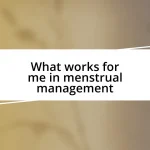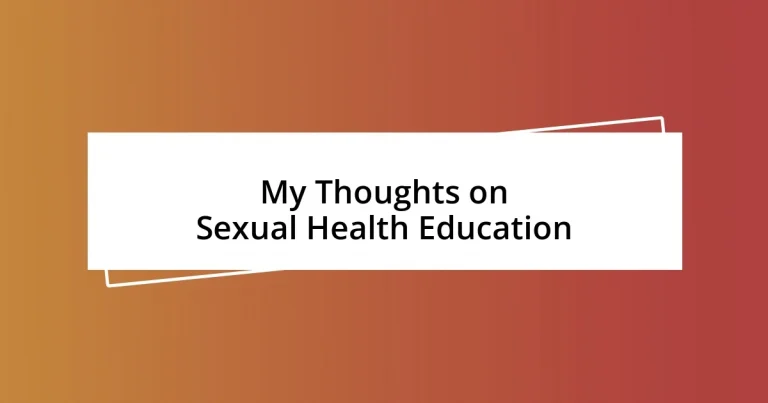Key takeaways:
- Comprehensive sexual health education encompasses emotional aspects, consent, communication, and the diverse spectrum of sexual orientations and identities, fostering informed and respectful relationships.
- Key topics such as safe sex practices, reproductive health, and the psychological dimensions of sexual experiences are crucial for a holistic understanding of sexual health.
- Effective teaching methods, including interactive approaches, real-world scenarios, and supportive environments, enhance student engagement and help address misconceptions surrounding sexual health education.
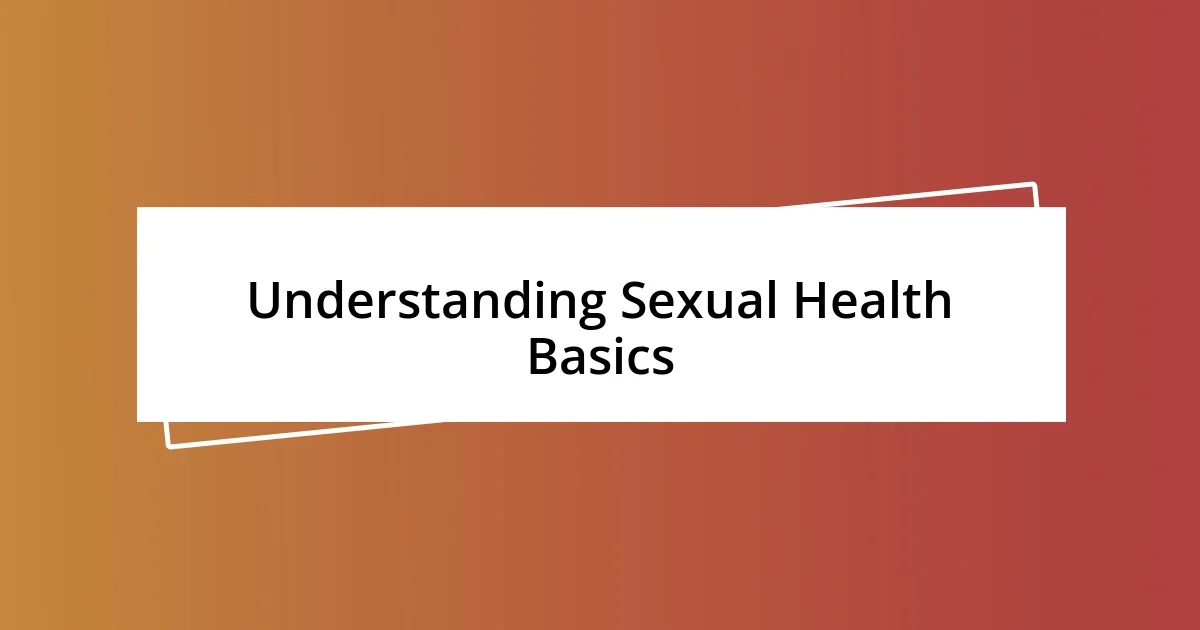
Understanding Sexual Health Basics
Sexual health is about so much more than just avoiding disease. I remember my high school health class, where we briefly touched on anatomy and contraception, but it felt incomplete. Why weren’t we discussing emotional aspects or healthy relationships? These elements are just as essential for a well-rounded understanding of sexual health.
Understanding consent is a foundational aspect of sexual health. Reflecting on my experiences, I can’t help but think about the importance of open communication in relationships. Have you ever been in a situation where you felt unsure about what your partner wanted? It’s crucial to foster an environment where discussing boundaries and desires is not only accepted but encouraged.
Another key component is recognizing the role of sexual orientation and identity in our conversations about health. Growing up, I struggled to find resources that acknowledged the spectrum of identities. It’s vital to provide inclusive education that addresses everyone’s experiences—don’t you think? This not only empowers individuals but also cultivates empathy and understanding among peers.
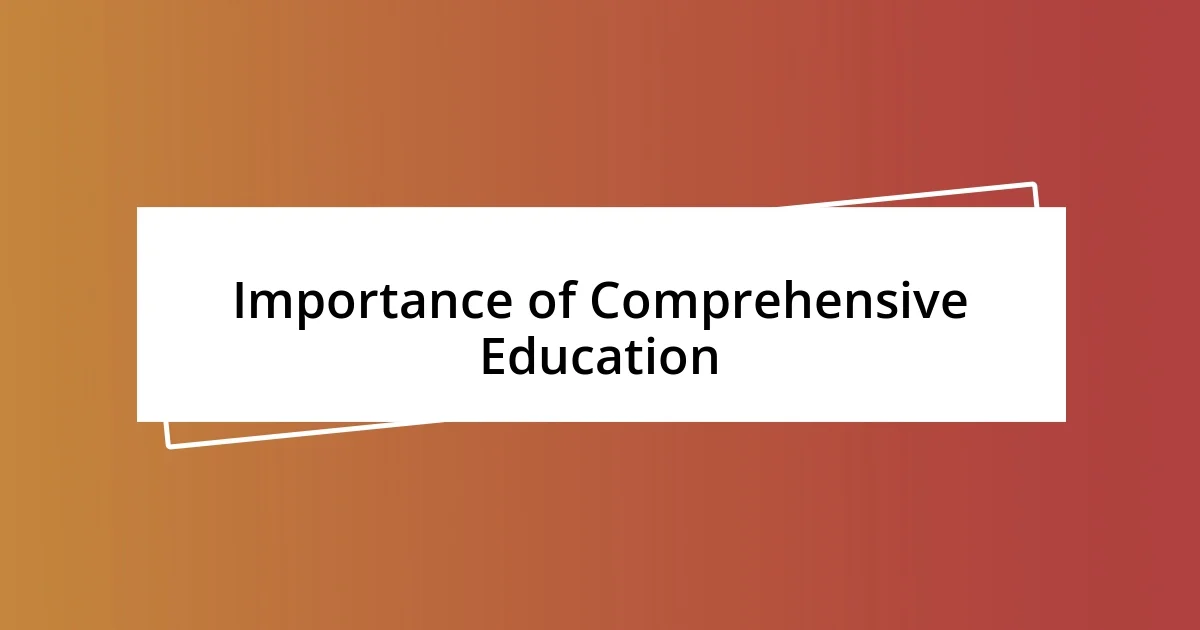
Importance of Comprehensive Education
Comprehensive sexual health education is essential because it lays the groundwork for informed decision-making. I vividly recall a friend of mine who entered a relationship without understanding emotional intimacy. She often felt lost and confused about her feelings, wishing she had been better prepared through education that not only covered the biological aspects but also the emotional and relational dimensions of sexual health. This type of education can build confidence and foster resilience in young people as they navigate their relationships.
Here’s why comprehensive education matters:
- It promotes informed choices, allowing individuals to make decisions that align with their values.
- It encourages healthy relationships, emphasizing respect, consent, and effective communication.
- It helps dismantle stigma surrounding sexual health topics, creating a more open dialogue.
- It can reduce rates of sexually transmitted infections and unintended pregnancies by equipping individuals with the necessary knowledge.
- It fosters a better understanding of diverse sexual orientations and identities, ensuring everyone feels represented and acknowledged.
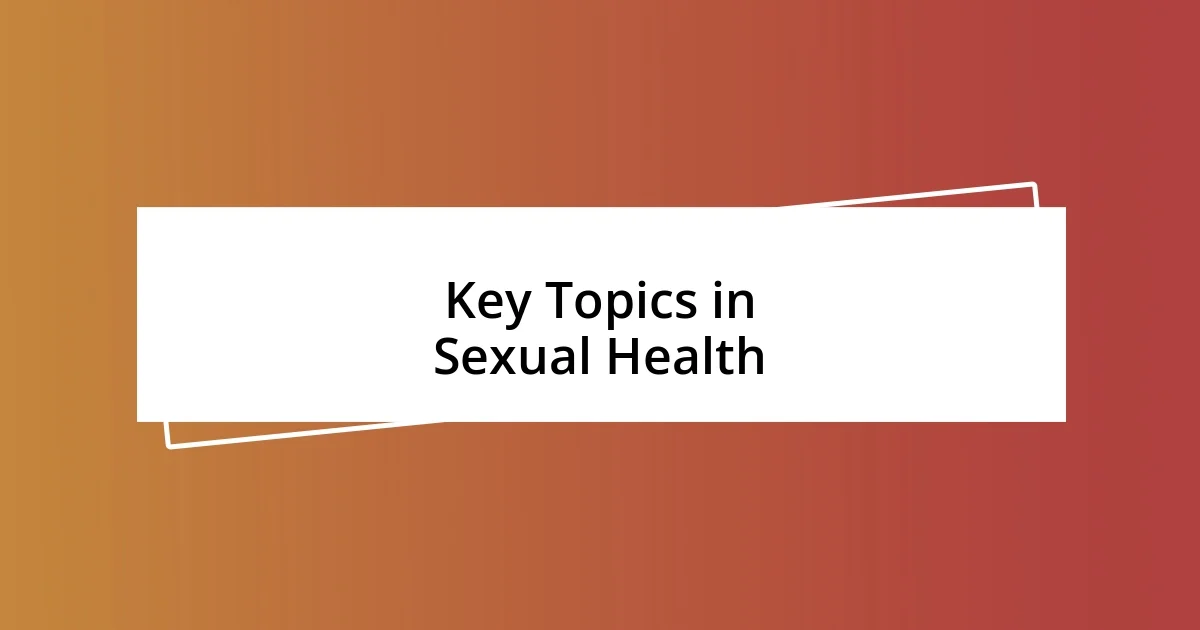
Key Topics in Sexual Health
Understanding key topics in sexual health is crucial for fostering a well-rounded perspective. One vital area is safe sex practices, which I often reflect on from my college days. It’s astonishing how many misconceptions I encountered around condom usage and STIs. Safe practices aren’t merely precautionary; they’re empowering. When we understand how to protect ourselves and our partners, we not only enhance physical health but also develop confidence in our sexual interactions.
Another essential topic is reproductive health, which encompasses knowledge about contraception, pregnancy, and regular health check-ups. During a health seminar I attended, I was struck by the number of people who were unaware of the various birth control methods and their effects. Whether it’s the Pill, IUDs, or barrier methods, awareness and understanding can significantly influence decisions regarding personal health and reproductive choices.
Lastly, the psychological aspects of sexual health, including emotional well-being and mental health’s tie to sexual experiences, should never be overlooked. I remember speaking with a friend about how anxiety affected their ability to connect in intimate situations. The emotional landscape can be as complex as the physical one, and addressing mental health in sexual health discussions encourages a holistic approach that nurtures both body and mind.
| Key Topic | Description |
|---|---|
| Safe Sex Practices | Education on protection methods and STI prevention. |
| Reproductive Health | Understanding contraception and routine health screenings. |
| Psychological Aspects | The connection between emotional well-being and sexual experiences. |
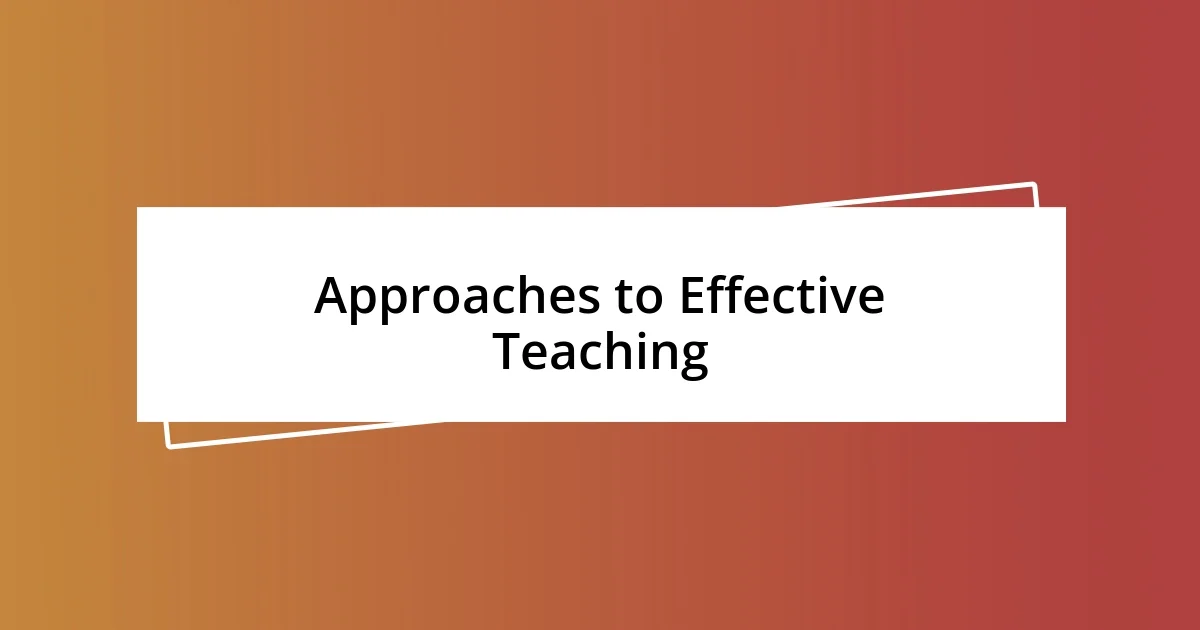
Approaches to Effective Teaching
Adopting an interactive approach can significantly enhance the effectiveness of teaching sexual health. For instance, I remember a workshop where we engaged in role-play scenarios to practice consent and communication skills. This hands-on experience not only made the learning process enjoyable but also instilled a deeper understanding and respect for boundaries. Isn’t it much easier to grasp these concepts when we’re actively participating rather than just listening to a lecture?
Incorporating diverse teaching methods also appeals to various learning styles, making education more inclusive. I often think back to the creative projects we collaborated on, such as creating informative posters on healthy relationships. This not only fostered teamwork but also encouraged critical thinking about topics that can feel uncomfortable to discuss. Have you ever noticed how sharing creative ideas can break down barriers and open up those essential conversations?
Lastly, providing a safe environment for discussions is paramount. I’ve found that when students feel comfortable sharing their thoughts and questions, it leads to richer dialogue and a more profound learning experience. One time, a classmate bravely shared their story about navigating a tough relationship, which prompted a discussion that resonated with many of us. Isn’t it amazing how personal experiences can transform a simple lesson into a meaningful connection?
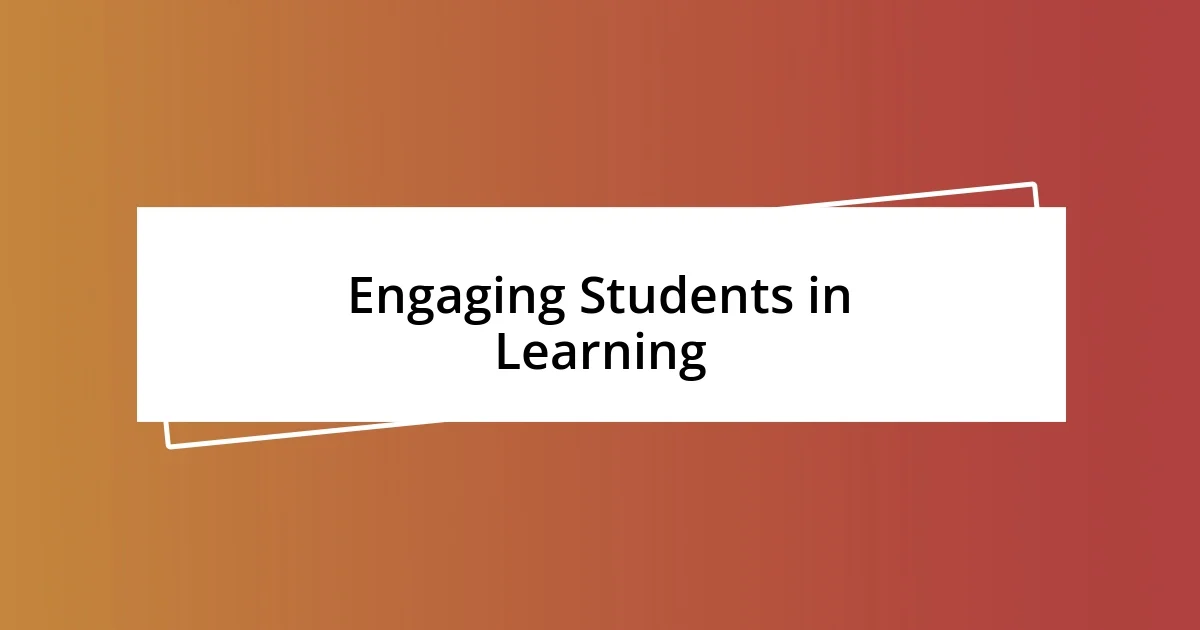
Engaging Students in Learning
Engaging students in learning is all about creating a dynamic atmosphere where participation is valued. I recall attending a seminar where we used innovative technology, like apps for anonymous Q&A sessions, to address questions students might shy away from asking openly. This interactive element not only sparked interest but also empowered us to voice our concerns and curiosities about sexual health. Have you ever felt more at ease discussing sensitive topics when there’s a barrier that makes it less daunting?
Additionally, utilizing real-world scenarios can be a game-changer. During one class, we participated in a discussion about current events related to sexual health, which drew on our varied backgrounds and experiences. It amazed me how much richer our conversations became when we connected textbook knowledge with what was happening in our lives. Does that not highlight how contextual learning can drive home important lessons?
Finally, I’ve learned that encouragement is key. In one instance, a peer shared their reluctance to engage due to embarrassment. I encouraged them to jump in and share their thoughts, and the difference was palpable—their voice added depth to our discussion and inspired others to share, creating a more vibrant learning environment. How often do we overlook the impact a little support can have on someone’s willingness to participate?
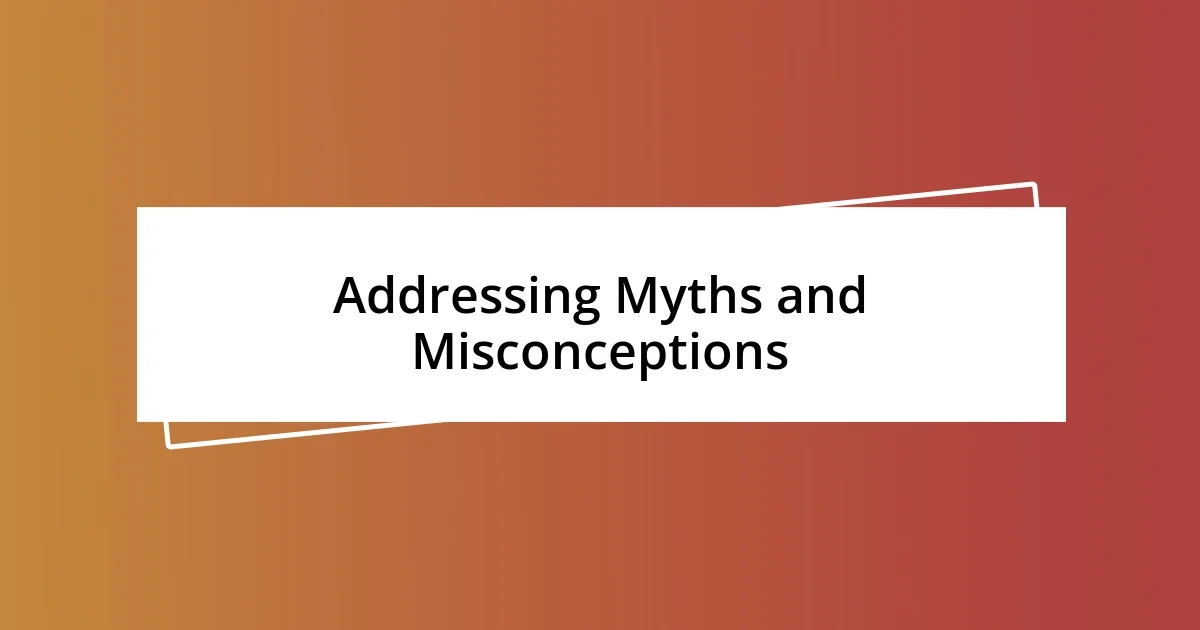
Addressing Myths and Misconceptions
Misconceptions surrounding sexual health education can often lead to discomfort and confusion among students. One common myth I often hear is that discussing sexual health encourages promiscuity. From my experience, having open dialogues creates safer spaces for students to navigate their questions and concerns, actually leading to healthier choices. Isn’t it odd how misunderstandings can create such a barrier to knowledge?
Another myth is the belief that sexual health education is only necessary for older students. I vividly remember a science class where we discussed puberty and consent with younger students, which opened their eyes to respecting boundaries early on. It was remarkable to see them engage eagerly with the information! Don’t you think starting this education early can help shape more responsible attitudes in the long run?
Lastly, many people assume that sexual health is solely about the physical aspects, neglecting the emotional and social components. I recall a poignant moment during a workshop focused on relationship dynamics, where students expressed their struggles with communication. It struck me how vital it is to address feelings, respect, and mutual understanding within the scope of sexual health education. Wouldn’t it make sense to incorporate such holistic views to prepare students for all aspects of their relationships?
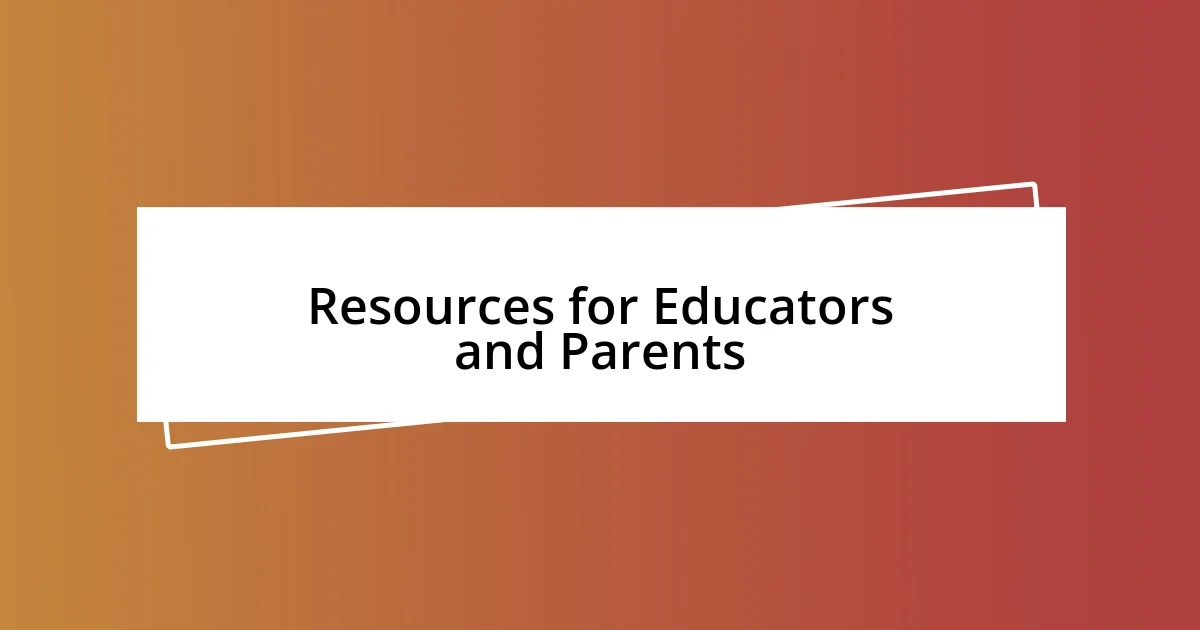
Resources for Educators and Parents
When it comes to resources for educators and parents, I believe a solid curriculum is essential. I remember digging into a comprehensive program that mixed evidence-based content with engaging activities, which made it way easier for me to navigate tough discussions. Having access to such structured materials can make all the difference, don’t you agree?
Online platforms have also become game-changers. I stumbled upon a website that offered webinars and downloadable lesson plans tailored for different age groups. It was nearly impossible to feel overwhelmed with all that support available, and it encouraged me to explore topics I might have felt unsure about. How empowering is it to have tools that not only inform but also inspire?
Lastly, community resources should never be overlooked. I discovered local organizations that provide workshops and support groups focused on sexual health education. Attending one of these sessions opened my eyes to the emotional aspects many parents often overlook. Isn’t it reassuring to know that we’re not in this alone and that there are people willing to share their insights and experiences?
